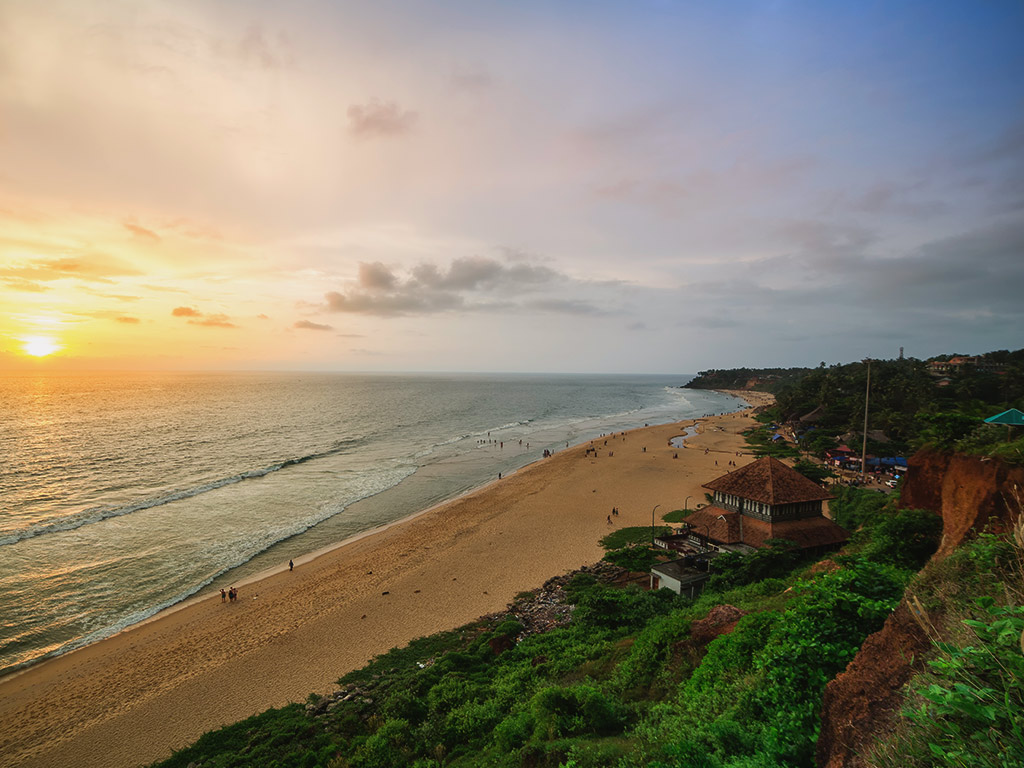

Travel about 3 km from Varkala town and you will reach one of the most popular pilgrim destinations of Kerala – Sivagiri Mutt. It is also the headquarters of the Sree Narayana Dharma Sangham, an organization of the great reformer Sree Narayana Guru’s disciples and followers.
The Mutt campus sprawls over an area of 200 acres and you will surely be attracted by the distinctive multi-tiered white terraces of the mutt, once you enter there. Situated at an elevated plateau, the mutt is considered sacred. It is here that the social reformer and sage Sree Narayana Guru breathed his last in 1928. The Samadhi or the final resting place of the Guru is situated on a hillock here and it attracts thousands of pilgrims. There is also the Guru’s residence and it displays his personal belongings.
You can also see a Sharada temple here. The main idol, Goddess Saraswati, here was consecrated by the Guru himself.
History
Sree Narayana Guru was attracted by the nature’s beauty and the calm ambience at Varkala and built a hermitage on top of the Sivagiri hill in 1904, which later turned out to be a major pilgrim centre. Later the Travancore State Government granted Sivagiri Hill to the Guru and some people near the place also offered land to him. Thus Sivagiri turned out to be the nerve centre of all Sree Narayana Movements.
Apart from the Guru, there were many social reformers who helped establish the Mutt at Sivagiri. The socio-political activist of yesteryears Dr. P. Palpu and the renowned Malayalam poet Kumaran Asan were some of them. They were ardent followers of the Guru and had distinct ideas on reformation of the society and Ezhava community.
Sree Narayana Guru understood and always stressed on the importance of education. Hence he set up an elementary school here. A night school was also founded for the illiterate people of an untouchable caste. When his disciples wanted to build a temple here, the Guru dedicated it to the Goddess of Knowledge, and consecrated the idol of Goddess Saraswathi here. Thus the Saradha (Saraswathi) temple here came into being in 1912.
Architecture and distinctive features of the temple
The Sivagiri Sarada temple is octagonal in shape and was planned and designed by the Guru himself. The Sarada temple here has windows, which were very uncharacteristic of a temple. The Guru called it Sarada Mutt and he wanted to dedicate it to Saraswathy, the Goddess of knowledge. The goddess is seated on a white lotus, indicating the knowledge blossoming on purity.
The rituals are also is different from that of other temples. While other temples perform nivedyam (offering of food to the deity) or abhishekam (pouring oil, ghee and such on the idol), Sharada temple is devoid of all such rituals, The devotees are free to worship the goddess reciting hymns. Guru, himself a writer and poet, wrote Janani-navaratna Manjari, in praise of the Goddess.
Apart from consecrating a symbolic idol and shunning all tantric rituals, the Guru also insisted on keeping high hygiene standards on the temple premises. His followers adhere to the Guru’s words now too and the temple is thus very different from other temples in the world.
Festivals
The Birthday and Samadhi day of the Guru which fall in August/September are observed at Sivagiri Mutt with much relevance. On Gurudeva Jayanthi day, the birthday of the Guru, colourful processions, debates, seminars, public meetings and cultural shows are conducted. Thousands of followers wearing yellow attire take part in the procession.
Another important festival here is Sivagiri pilgrimage which is observed on December 30- January 1. These days thousands of pilgrims in yellow attire from different parts of Kerala gather at the Samadhi of the Guru, who propagated his concept, "One Caste, One Religion and One God.’’
 Papanasham Papanasham | Thiruvambadi Sree Krishna Temple  |